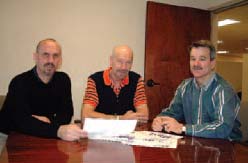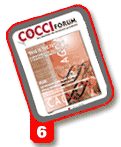COCCI Profile: Long-Range Planning
New tools and strategies are helping Wayne Farms to better manage coccidiosis while optimizing both product and bird performance
 Wayne nutritionist John Halley (left) with vets Don Waldrip and Marshall
Putnam: 'We've totally changed our approach to coccidiosis control.'
|
Managing coccidiosis in poultry
used to be a no-brainer.
Simply pick the feed additives
that work best in your operation and
rotate or shuttle them for maximum
performance and return.
"Ten years ago or so, we used to
look at our anticoccidial usage on a 6-
month basis. Now we're looking 2 or 3
years down the road," says Don
Waldrip, DVM, director of animal
health for Wayne Farms LLC, based in
Oakwood, Ga.
"Coccidiosis management is a lot
more complicated today," he adds.
"You need to position certain anticoccidials
by time of year, by length of
usage, by loss of sensitivity and other
factors. The decision-making process
on the use of coccidiostats has become
more involved. Deciding which anticoccidial
to use and what frequency is
increasingly more important."
The process is particularly challenging
at a large operation like Wayne
Farms, which every week processes
some 5 million large birds "mostly 7
to 7.4 pounds "from eight integrated
facilities in six states. Wayne is now the
sixth largest vertically integrated
processor in the United States.
No complaints
Waldrip sees the growing complexity of
coccidiosis management as a sign of
progress against the costly, tenacious
and ubiquitous protozoan disease that
continues to challenge poultry operations
worldwide.
"We used salinomycin for a long,
long time," adds William Elrod, live
production manager at the company's
Pendergrass complex. "So when we
went over to some of the other management
options available, we got a
significant boost in performance. It
really changed our whole philosophy
on coccidiosis management."
In the United States, Clinacox™
(diclazuril) "a new-generation synthetic
anticoccidial that is in a different
chemical family than other in-feed
treatments "is now letting many US
poultry operations clean up houses
infected by resistant wild strains of the
Eimeria parasite while boosting feed
efficiency an average of 5 points.
Looking to optimizing use of salinomycin
and other ionophores, Wayne
and many other progressive poultry
operations are also vaccinating for coccidiosis
instead of leaning entirely on
in-feed anticoccidials.
The poultry industry is developing a
better understanding of how to juggle
anticoccidial products for maximum
effectiveness. Research at the USDA,
for example, has shown that vaccinating
with Coccivac®-B, a live-oocyst vaccine
administered to day-old chicks in
the hatchery, renews the sensitivity of
an on-farm coccidial population to the
ionophore salinomycin.
Working through Schering-Plough
Animal Health and Greg Mathis, PhD,
of Southern Poultry Research, Inc., in
Athens, Ga., Wayne is now monitoring
sensitivities to Eimeria organisms from
the litter of its more than 2,500 houses.
Proactive, not reactive
"We've totally changed our approach to
coccidiosis control, from one of using
ionophore leakage to develop immunity
to a more performance-driven
scheme where leakage is not as important,"
explains Marshall Putnam, DVM,
director of poultry health at Wayne.
"We're taking a fuller, more integrated,
proactive approach to coccidiosis
control," he adds, "rather than a reactionary
approach, where you post birds
only when you're not satisfied with the
feed conversion and then decide to
change the control program."
In a perfect world, Waldrip and
Putnam say they'd devise a set rotation
using all types of anticoccidials "vaccines,
chemicals, ionophores "for
their more than 2,500 houses to follow.
But variances in temperatures, moisture
levels and other factors make it impossible
to implement a rigid, universal
program, especially for an operation
spread over six states.
"With coccidiosis, you have to consider
all your options and address it
with a long-range attack plan," Waldrip
says. "At the same time, you still need
to remain flexible to address the
unique circumstances of each farm.
The additional tools we have available
today help us accomplish that while
maintaining good performance."
Over the past 2 to 3 years, the
biggest change to Wayne's strategy has
been the use of vaccination for at least
three cycles in about 40% of its facilities.
Wayne first used Coccivac at its
operation in Laurel, Miss., where hot,
humid summers traditionally intensify
coccidiosis pressure.
Summertime cues
Wayne now uses Clinacox "either in
the starter and grower feeds for one
cycle or in the grower cycle only for
two cycles "to provide a foundation
for its coccidiosis program. The operation
then switches to Coccivac for three
cycles or more in most cases.
Not wanting to lose the well-documented
performance advantage of
Clinacox, Wayne likes to leave at least
12 months between treatments "a
goal that in reality "cycles out to 18
months or so, depending on where
we're at with our program," Waldrip
says.
No Hassles at the Feed Mill
From a logistics standpoint, Wayne's feed mills didn't have any problem with
incorporating the vaccine into their program. |
The need to rest in-feed anticoccidials
has helped to fuel even more interest
in vaccination. For example, one of
Wayne's complexes opted to forego
switching to an ionophore this past
winter and stay on Coccivac until
spring. One option would then be to
go to the ionophore and 3-Nitro
(arsenelic acid) for two cycles before
rotating to Clinacox during the summer.
After that, the plan is to go back to the
vaccine.
Going the distance
Bird performance isn't exactly suffering
in the meantime.
"After five cycles with the vaccine,
our Pendergrass [Georgia] complex
hasn't seen any downturn in performance,"
Waldrip says. "In fact, for some
reason, we find performance of vaccinated
birds tends to get better with
each successive cycle "possibly due
to a shift in Eimeria populations."
The only concern Waldrip has about
vaccinating in winter is that some complexes
may be tempted to hold birds in
the partial house to save on heating
costs "a situation that could expose
them to higher concentrations of recycled
oocysts.
"It really depends on the moisture
level of the litter and weather conditions,
but as a general rule, we like to
see vaccinated birds turned out no later
than 14 days," he says. "If you do that
and maintain a good facility with good
ventilation and litter management, you
shouldn't have any problems using
Coccivac year-round."
Putnam agrees. "Good management
is key to the success of any health program,
whether it's coccidiosis or any
other poultry disease," he adds.
"Anyone who thinks they have to make
a lot of changes in their program before
using Coccivac has the cart before the
Maintaining Uniform Coverage and Protection
The development of new technology for
administering Coccivac has helped
Wayne seamlessly incorporate vaccination
into its coccidiosis-management program. |
horse. If houses are not being managed
properly or if litter moisture levels are
too high, there is a possibility that any
coccidiosis program may fail. Good
house management is a prerequisite for
the use of any anticoccidial product."
Balanced nutrition is also critical to
flock health. But in Wayne's case,
switching to a coccidiosis vaccine didn't
require changing the company's
feed regimen.
"We raise large birds, some up to 7.5
pounds, so we tend to use a fairly
dense nutrient package because we're
looking for yield," says company nutritionist
John Halley, PhD.
"If you're raising smaller birds, you
need to make sure the nutrients are
there to maintain performance after
vaccination. You need adequate levels
of vitamins E and A, a sufficient crude
protein level, and make sure that the
amino acids are high."
As good or better
Wayne keeps performance figures confidential,
but according to the technical
team at the company, vaccinating for
coccidiosis instead of using a feed additive
has helped to maintain or even
improve performance.
"We've used Coccivac in several
locations for 2 or 3 years now and we
can't tell any significant difference in
performance between vaccinated birds
and those treated with an ionophore
with 3-Nitro," Halley says. "It's been
our experience that vaccinated birds
perform as well or, in some cases, even
better. The vaccine also lets us break
up the use of the feed additives, so
they'll be more effective for us in the
future."
John Moore, broiler manager at
Wayne's Pendergrass facility, has heard
similar reports from other complexes.
"The vaccinated birds might start off
a little slower, but they get over the initial
reaction quickly and make up for
lost time," he says. "Our weights are
the same or possibly better."
Source: CocciForum Issue No.6, Schering-Plough Animal Health.











